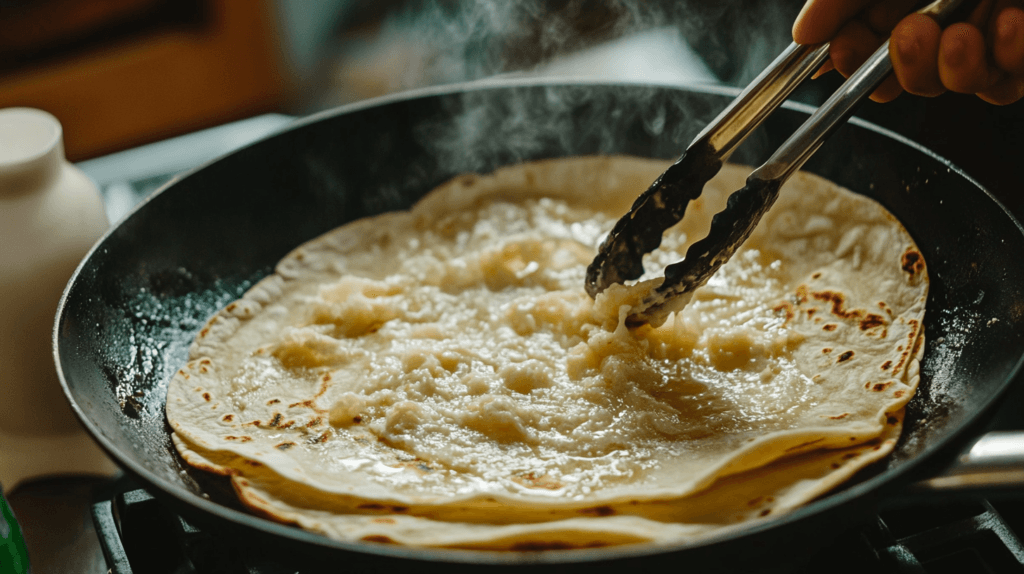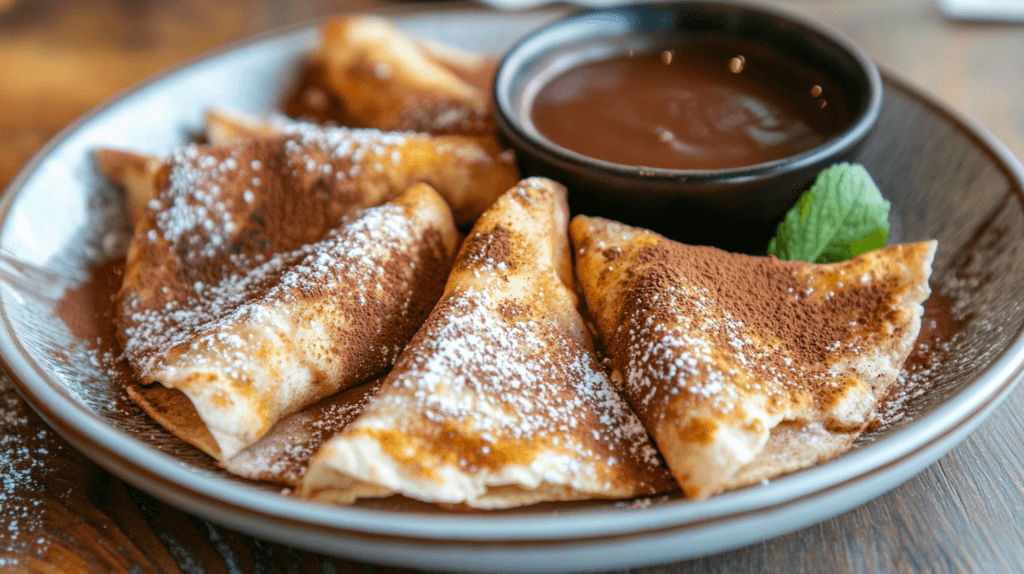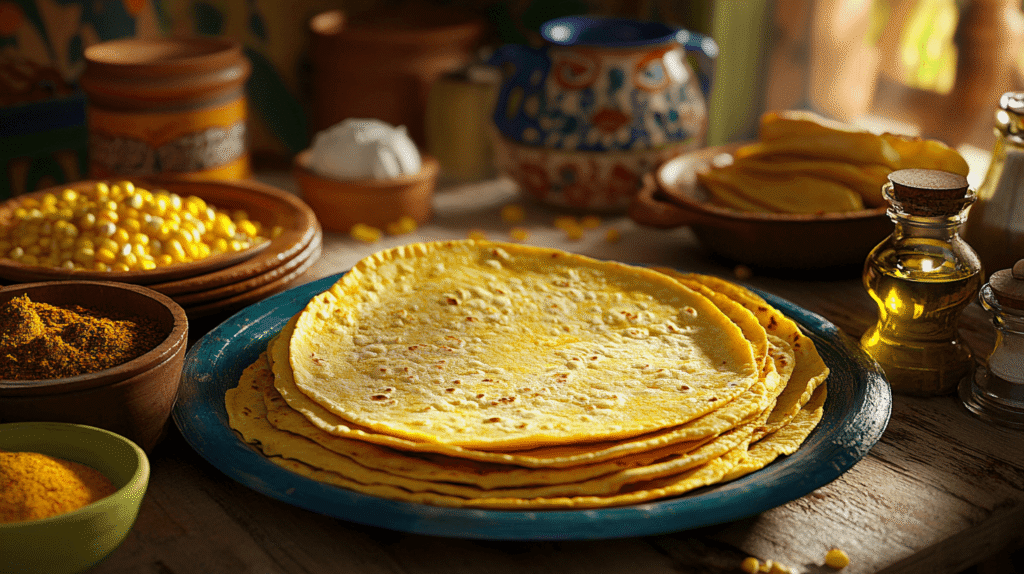How to fry corn tortillas is a question many home cooks ask when aiming to achieve the perfect crispy texture for their favorite dishes. Whether you’re preparing tortilla chips, crunchy tostadas, or taco shells, learning the proper way to fry corn tortillas can take your culinary creations to the next level. By following a few simple steps, you can transform ordinary tortillas into a flavorful, versatile base for countless recipes.
This guide covers everything you need to know about frying corn tortillas, including tools, ingredients, step-by-step instructions, and creative ways to use them. Let’s dive in!
Table of Contents
Tools and Ingredients Needed for How to Fry Corn Tortillas
Essential Tools
Having the right tools is essential for a safe and efficient frying process. Here’s a closer look at each item and why it matters:
- Frying Pan or Skillet
- Use a heavy-bottomed pan or cast-iron skillet to ensure even heat distribution. Uneven heating can lead to tortillas cooking unevenly, with some parts burning while others remain undercooked.
- Tongs
- A good pair of tongs is essential for flipping tortillas and removing them from the hot oil. They allow you to handle the tortillas without splashing oil or risking burns. Look for long-handled tongs to keep your hands safely away from the heat.
- Paper Towels or Wire Rack
- Use paper towels to absorb excess oil after frying. For an even crispier result, a wire cooling rack allows air to circulate around the tortilla as it cools, preventing sogginess.
- Thermometer (Optional)
- Maintaining the correct oil temperature (350°F–375°F) is crucial for perfect frying. A kitchen thermometer ensures accuracy and helps avoid guesswork, reducing the risk of overcooking or undercooking.
- Slotted Spoon or Spider Strainer
- While not mandatory, these tools are helpful for retrieving small pieces or tortilla chips from the oil.
Ingredients for Frying
Choosing high-quality ingredients is just as important as using the right tools.
- Corn Tortillas
- Fresh corn tortillas are ideal for frying, as they absorb less oil and produce a better texture. Store-bought or homemade tortillas work, but opt for those without added preservatives for the most authentic flavor.
- Oil
- Use oils with a high smoke point, such as:
- Canola oil: Affordable and neutral in flavor.
- Vegetable oil: Widely available and cost-effective.
- Avocado oil: A healthier option with a slightly nutty flavor.
- Use oils with a high smoke point, such as:
- Optional Seasonings
- To enhance the flavor, consider adding seasoning before or after frying:
- Salt: Sprinkle immediately after frying for better adherence.
- Chili powder: Adds a spicy kick.
- Paprika: Provides a smoky undertone.
- To enhance the flavor, consider adding seasoning before or after frying:
Choosing the Right Corn Tortillas
Selecting the best tortillas is a crucial first step in ensuring your fried tortillas turn out perfectly.
Freshness Matters
- Why Freshness Is Important
Fresh tortillas produce better results because they have a lower moisture content and maintain their structure during frying. Older tortillas can become brittle or overly oily when fried. - How to Identify Fresh Tortillas
- Check the expiration date on store-bought packages.
- Look for soft, pliable tortillas that fold without cracking.
- Fresh tortillas often have a slightly sweet, corn-like aroma.
Store-Bought vs. Homemade Tortillas
Both store-bought and homemade tortillas can be used for frying, but each comes with unique advantages:
- Store-Bought Tortillas
- Pros: Convenient, consistent in size, and readily available in various thicknesses.
- Cons: May contain preservatives that slightly alter the flavor.
- Homemade Tortillas
- Pros: Fresher, customizable in size and thickness, and free from additives.
- Cons: Time-consuming to prepare.
- Tip: If making tortillas at home, use a tortilla press for even thickness and consistency.
Thickness and Size Considerations
- Thickness
Thicker tortillas may require slightly longer frying times but yield a hearty crunch, perfect for tostadas or tortilla chips. Thinner tortillas fry more quickly and work well for crispy taco shells. - Size
- Small tortillas (4–5 inches) are great for chips or mini tacos.
- Medium tortillas (6–8 inches) are ideal for tostadas and regular tacos.
- Large tortillas (10 inches or more) are suitable for burritos or oversized chips.
Types of Oils for Frying Corn Tortillas
The choice of oil can greatly impact the flavor, texture, and nutritional value of fried tortillas.
Best Oils to Use
When frying corn tortillas, opt for oils with high smoke points to ensure safety and flavor retention. Here are some of the best options:
- Canola Oil
- Smoke Point: 400°F
- Flavor: Neutral, allowing the tortilla’s natural taste to shine through.
- Benefits: Affordable, widely available, and works well for large batches.
- Vegetable Oil
- Smoke Point: 400°F–450°F (varies by brand)
- Flavor: Neutral, similar to canola oil.
- Benefits: Easy to find and cost-effective.
- Avocado Oil
- Smoke Point: 520°F
- Flavor: Slightly nutty, which complements the corn flavor.
- Benefits: Rich in healthy fats and antioxidants.
- Peanut Oil
- Smoke Point: 450°F
- Flavor: Mildly nutty but not overpowering.
- Benefits: Great for frying due to its high heat tolerance.
Oils to Avoid
Some oils are not well-suited for frying due to their low smoke points or strong flavors:
- Olive Oil
- Smoke Point: 325°F–375°F (extra virgin)
- Why Avoid: Burns quickly and can impart a strong, unwanted flavor.
- Coconut Oil
- Smoke Point: 350°F
- Why Avoid: Adds a strong coconut flavor, which may not pair well with savory tortillas.
- Butter or Margarine
- Why Avoid: These contain water and solids that burn quickly, making them unsuitable for frying.
Tips for Managing Oil During Frying
Use just enough oil to submerge the tortillas. A depth of about 1–2 inches is sufficient for most frying tasks.
Avoid Overheating
Overheated oil can burn tortillas and produce harmful compounds. Monitor the oil temperature and adjust the heat as needed.
Reusing Oil
Strain the oil after frying to remove debris, and store it in an airtight container for future use. Avoid reusing oil more than 2–3 times, as it can degrade.
Amount of Oil
Preparing Corn Tortillas for Frying
Drying and Cutting Techniques
Before frying, ensure your tortillas are free from excess moisture. Damp tortillas can cause the oil to splatter, leading to safety hazards and uneven frying.
- Drying: Pat each tortilla with a paper towel to remove surface moisture.
- Cutting: Depending on your dish, cut tortillas into desired shapes:
- Triangles: Perfect for chips.
- Strips: Ideal for salads or soups.
- Whole: Great for tostadas or taco shells.
Optional Pre-Seasoning
Adding spices or a light brush of lime juice before frying can elevate the flavor profile of your tortillas. Popular seasoning options include:
- Paprika
- Garlic powder
- Chili powder
- A sprinkle of salt
Step-by-Step Guide to Fry Corn Tortillas

Heating the Oil
The first step is heating your oil to the correct temperature. Here’s how:
- Fill Your Pan: Add about 1-2 inches of oil to your frying pan.
- Heat Gradually: Use medium-high heat to reach a temperature of 350°F to 375°F.
- If you don’t have a thermometer, test the oil by dropping a small piece of tortilla into it. If it sizzles and rises to the surface, the oil is ready.
Frying Process
- Place the Tortilla: Gently lay one tortilla into the hot oil. Avoid overcrowding the pan to maintain consistent heat.
- Flip It: After 15-20 seconds, use tongs to flip the tortilla to the other side.
- Monitor for Bubbles: Small bubbles forming on the surface are a sign that the tortilla is frying evenly.
- Remove: When the tortilla turns golden and crisp, remove it with tongs.
Checking Doneness
A perfectly fried tortilla should have a golden-brown hue and a crispy texture. Test one piece to ensure it’s not too oily or undercooked.
Common Mistakes and How to Avoid Them
Overcrowding the Pan
Adding too many tortillas at once lowers the oil temperature, leading to soggy and unevenly fried tortillas. Fry in small batches to maintain crispness.
Wrong Oil Temperature
- Too Hot: The tortillas burn quickly.
- Too Cold: Tortillas absorb excess oil, becoming greasy.
Keep an eye on the oil temperature throughout the process, adjusting the heat as needed.
Uses for Fried Corn Tortillas

Recipes with Fried Corn Tortillas
Fried corn tortillas are incredibly versatile. Use them in dishes like:
- Tacos: Create hard-shell tacos for added crunch.
- Tostadas: Build a tostada by layering beans, meat, and toppings.
- Nachos: Pile fried tortilla chips with cheese, jalapeños, and salsa.
Creative Ideas
Fried tortillas aren’t just for savory dishes. Try using them in unique ways:
- Dessert Tortillas: Sprinkle fried tortillas with cinnamon and sugar.
- Salad Toppers: Cut tortillas into thin strips and use them to garnish salads for extra texture.
Tips for Perfectly Fried Tortillas Every Time
Timing is Everything
The key to achieving the perfect fried tortilla is timing:
- Thin Tortillas: Fry for 20–30 seconds per side to prevent overcooking.
- Thicker Tortillas: Fry for up to 40 seconds per side, ensuring the heat penetrates evenly.
Over-frying can lead to a bitter taste, so keep a close eye on them as they cook.
The Cooling Process
After frying, transfer the tortillas to a plate lined with paper towels. This step absorbs excess oil and keeps them crisp. Arrange them in a single layer to prevent sogginess.
Storing Fried Corn Tortillas
Short-Term Storage
If you plan to use your fried tortillas within a few hours:
- Room Temperature: Keep them on a plate lined with paper towels and lightly cover them with a clean kitchen towel.
- Oven Warming: Set your oven to the lowest temperature (around 200°F) and place the tortillas on a baking sheet to stay warm and crisp.
Long-Term Storage
For long-term storage, fried tortillas can be frozen:
- Cool Completely: Ensure tortillas are completely cool before freezing to avoid condensation.
- Layer with Parchment Paper: Place parchment paper between tortillas to prevent sticking.
- Store in Airtight Containers: Use freezer-safe bags or containers.
To reheat, bake them at 350°F for a few minutes or warm them in a dry skillet.
Nutritional Information
Fried vs. Baked Tortillas
While fried tortillas are undeniably delicious, they can be higher in calories and fat due to the oil absorption. Comparatively, baked tortillas are a healthier option but lack the signature crunch and flavor of fried ones.
How to Make Healthier Fried Tortillas
- Drain Excess Oil: Use paper towels liberally after frying.
- Use a Spray Bottle: Lightly spray tortillas with oil instead of submerging them.
- Air Fryer Method: An air fryer can produce similar results with significantly less oil.
Frequently Asked Questions (FAQs)
Can I Fry Tortillas Without Oil?
Yes, you can use alternative methods like air frying or dry toasting in a non-stick skillet. While these methods don’t deliver the same richness, they’re a healthier option.
How Do I Keep Fried Tortillas from Getting Soggy?
To maintain crispness:
- Cool them on a wire rack instead of stacking.
- Store them in a single layer or with parchment paper between layers.
Learn more about preserving textures in recipes like Crispy Fried Corn Recipes.
What’s the Best Tortilla Size for Frying?
The size depends on your dish:
- Small (4-5 inches): Perfect for chips or mini tostadas.
- Medium (6-8 inches): Best for tacos and tostadas.
- Large (10 inches or more): Ideal for burritos or large tortilla chips.
Explore pairing options for tacos in What to Serve with Fish Tacos.
Conclusion
Frying corn tortillas is a simple yet transformative technique that brings authentic texture and flavor to countless dishes. From crispy tacos to golden tortilla chips, the possibilities are endless. By following this guide, you’ll have perfectly fried tortillas every time—versatile, delicious, and sure to impress your family and friends. For more ways to enhance your cooking, see our guide on Making Taco Bowls.
Printable Recipe Card
Want just the essential recipe details without scrolling through the article? Get our printable recipe card with just the ingredients and instructions.

